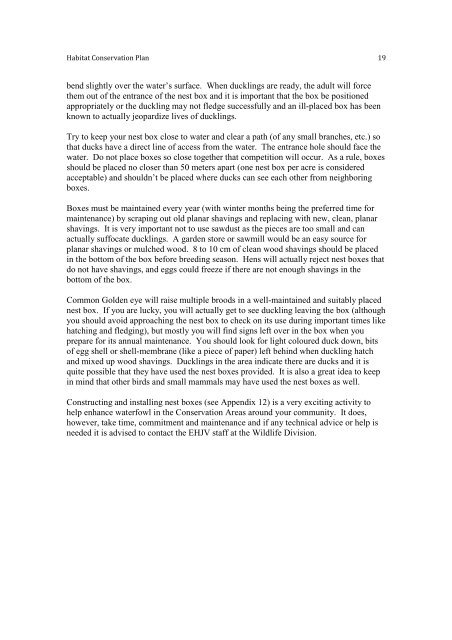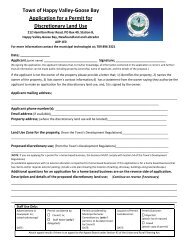Habitat Conservation Plan Habitat Conservation Plan for the Town ...
Habitat Conservation Plan Habitat Conservation Plan for the Town ...
Habitat Conservation Plan Habitat Conservation Plan for the Town ...
- No tags were found...
Create successful ePaper yourself
Turn your PDF publications into a flip-book with our unique Google optimized e-Paper software.
<strong>Habitat</strong> <strong>Conservation</strong> <strong>Plan</strong> 19bend slightly over <strong>the</strong> water’s surface. When ducklings are ready, <strong>the</strong> adult will <strong>for</strong>ce<strong>the</strong>m out of <strong>the</strong> entrance of <strong>the</strong> nest box and it is important that <strong>the</strong> box be positionedappropriately or <strong>the</strong> duckling may not fledge successfully and an ill-placed box has beenknown to actually jeopardize lives of ducklings.Try to keep your nest box close to water and clear a path (of any small branches, etc.) sothat ducks have a direct line of access from <strong>the</strong> water. The entrance hole should face <strong>the</strong>water. Do not place boxes so close toge<strong>the</strong>r that competition will occur. As a rule, boxesshould be placed no closer than 50 meters apart (one nest box per acre is consideredacceptable) and shouldn’t be placed where ducks can see each o<strong>the</strong>r from neighboringboxes.Boxes must be maintained every year (with winter months being <strong>the</strong> preferred time <strong>for</strong>maintenance) by scraping out old planar shavings and replacing with new, clean, planarshavings. It is very important not to use sawdust as <strong>the</strong> pieces are too small and canactually suffocate ducklings. A garden store or sawmill would be an easy source <strong>for</strong>planar shavings or mulched wood. 8 to 10 cm of clean wood shavings should be placedin <strong>the</strong> bottom of <strong>the</strong> box be<strong>for</strong>e breeding season. Hens will actually reject nest boxes thatdo not have shavings, and eggs could freeze if <strong>the</strong>re are not enough shavings in <strong>the</strong>bottom of <strong>the</strong> box.Common Golden eye will raise multiple broods in a well-maintained and suitably placednest box. If you are lucky, you will actually get to see duckling leaving <strong>the</strong> box (althoughyou should avoid approaching <strong>the</strong> nest box to check on its use during important times likehatching and fledging), but mostly you will find signs left over in <strong>the</strong> box when youprepare <strong>for</strong> its annual maintenance. You should look <strong>for</strong> light coloured duck down, bitsof egg shell or shell-membrane (like a piece of paper) left behind when duckling hatchand mixed up wood shavings. Ducklings in <strong>the</strong> area indicate <strong>the</strong>re are ducks and it isquite possible that <strong>the</strong>y have used <strong>the</strong> nest boxes provided. It is also a great idea to keepin mind that o<strong>the</strong>r birds and small mammals may have used <strong>the</strong> nest boxes as well.Constructing and installing nest boxes (see Appendix 12) is a very exciting activity tohelp enhance waterfowl in <strong>the</strong> <strong>Conservation</strong> Areas around your community. It does,however, take time, commitment and maintenance and if any technical advice or help isneeded it is advised to contact <strong>the</strong> EHJV staff at <strong>the</strong> Wildlife Division.






